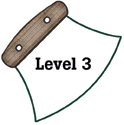
Alaska Science
Key Element A8a
A student who meets the content standard should understand the scientific principles and models that describe the nature of physical, chemical, and nuclear reactions (Energy Transformations).
 |
Alaska Science A student who meets the content standard should understand the scientific principles and models that describe the nature of physical, chemical, and nuclear reactions (Energy Transformations). |
|
Performance Standard Level 3, Ages 11–14
|
|
|
|
Sample Assessment Ideas
|
|
|
Expanded Sample Assessment Idea
|
|
Materials
Procedure NOTE: Proper safety procedures must be followed! Students will:
Reflection and Revision
|
Levels of Performance |
||
|
Stage 4 |
Student work is complete, correct and shows evidence of logical reasoning and the transfer and extension of knowledge regarding chemical vs. physical change and properties. Student work includes detailed observations and accurate models that demonstrate the conservation of atoms in chemical reactions. The models are used to interpret experimental observations including the presence of non-reacted materials and the principle that correct ratios are required for a complete reaction. | ||
|
Stage 3
|
Student work is mostly complete and shows evidence of reasoning and the transfer or extension of knowledge regarding chemical vs. physical change and properties. Student work may contain minor errors or omissions but it includes some detailed observations as well as models that demonstrate the interaction of atoms in chemical reactions. The models are used to explain some experimental observations and the need for correct ratios. | ||
|
Stage 2
|
Student work may be incomplete, and shows limited evidence of knowledge regarding the difference between physical and chemical properties or changes. Experimental observations lack detail, models may show evidence of skilled craftsmanship but flawed reasoning is used to explain chemical reactions. | ||
|
Stage 1
|
Student work is mostly incomplete and shows evidence of misconceptions regarding physical and chemical properties and changes. Observations are minimal or totally incorrect and models may be incorrect or cannot be used to explain chemical reactions. | ||
Standards Cross-References
|
||
|
National Science Education Standards Substances react chemically in characteristic ways with other substances to form new substances (compounds) with different characteristic properties. In chemical reactions, the total mass is conserved. Substances often are placed in categories or groups if they react in similar ways; metals is an example of such a group. (Page 154) Chemical elements do not break down during normal laboratory reactions involving such treatments as heating, exposure to electric current, or reaction with acids. There are more than 100 known elements that combine in a multitude of ways to produce compounds, which account for the living and nonliving substances that we encounter. (Page 154) In most chemical and nuclear reactions, energy is transferred into or out of a system. Heat, light, mechanical motion, or electricity might all be involved in such transfers. (Page 155) |
Benchmarks Atoms and molecules are perpetually in motion. Increased temperature means greater average energy of motion, so most substances expand when heated. In solids, the atoms are closely locked in position and can only vibrate. In liquids, the atoms or molecules have higher energy of motion, are more loosely connected, and can slide past one another; some molecules may get enough energy to escape into a gas. In gases, the atoms or molecules have still more energy of motion and are free of one another except during occasional collisions. (Page 78) There are groups of elements that have similar properties, including highly reactive metals, less reactive metals, highly reactive nonmetals (such as chlorine, fluorine, and oxygen), and some almost completely nonreactive gases (such as helium and neon). An especially important kind of reaction between substances involves combinations of oxygen with something else—as in burning or rusting. Some elements don’t fit into any of the categories; among them are carbon and hydrogen, essential elements of living matter. (Page 78) No matter how substances within a closed system interact with one another, or how they combine or break apart, the total weight of the system remains the same. The idea of atoms explains the conservation of matter: if the number of atoms stays the same no matter how they are rearranged, then their total mass stays the same. (Page 79) |
|
Table of Contents | Return to Alaska Native Knowledge Network